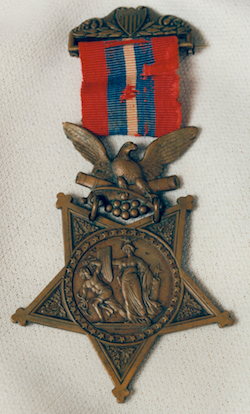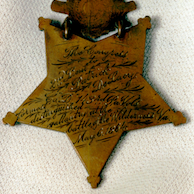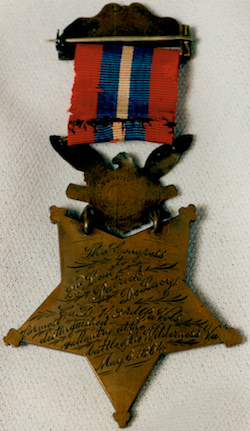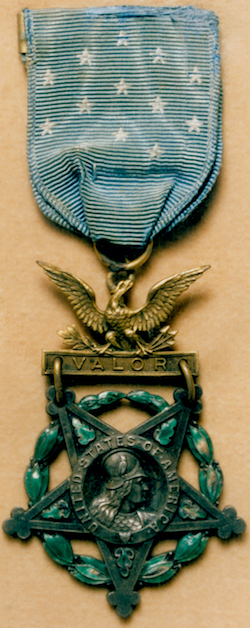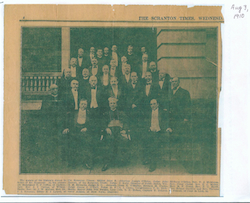Patrick DeLacy’s Medal of Honor. Produced by the Philadelphia Mint, the Medal features an inverted five-point star with a cluster of laurel for victory and oak for strength. Inside the star, a circle shows 34 stars–one for each state in the U.S. in 1862 (including the 11 Confederate states). Inside the circle are two figures. On the right is Minerva, Roman goddess of war and wisdom. An owl on her helmet represents wisdom. In her left hand, she holds an ax and several rods, symbolizing authority. In her right hand, she holds the shield of the United States. The figure on the left is a man holding snakes, representing Discord. Thus the Medal symbolizes “Minerva repulsing Discord”–in other words, the Union trying to prevent the dissolution of the United States. At the top of the Medal is an eagle – which represents the United States–holding a saber and cannon in its talons (the U.S. Army version of the Medal)
Each holder’s Medal is inscribed to them specifically on its reverse. On the back of DeLacy’s Medal, it is engraved: “The Congress to 2nd Lt. Patrick DeLacy Co. “D” 143rd PA Vols. for most distinguished gallantry at battle of Wilderness, Va. May 6, 1864
Long view of the reverse of DeLacy’s Medal with 1896 ribbon, which was designed to replace the original red-and-white striped ribbon version and to create a distinctive look apart from the medals of other veterans’ organizations like the Grand Army of the Republic (GAR).
DeLacy’s 1904 Medal. He did not receive another Medal of Honor for a different battle. The Army re-designed the Medal to protect it from being copied–this version is called the “Gillespie.” The words “United States of America” replaced the ring of 34 stars. In the center, the profile of the goddess of war wearing a helmet took the place of the “Minerva Repelling Discord” motif. The laurel clusters (enameled green) moved to the open wreath that formed the circle around the big 5-pointed star; the oak clusters (also enameled green) stayed in their original position at the points of the star. The eagle atop the crossed saber and cannon became an eagle perched on a bar with the word “Valor” on it and shafts of arrows. The ribbon changed to a light blue background with 13 white stars representing the original colonies.
Two Medal of Honor recipients are pictured in this August 3, 1910 issue of the Scranton Times recounting a “Bishop’s Dinner” in honor of President Teddy Roosevelt, who had just finished his second term the year before this picture was taken. Roosevelt is seated in the bottom row at left. In the next row and to the right is Patrick DeLacy. DeLacy received his Medal for the Wilderness in the Civil War. Roosevelt received his posthumously in 2001 for his action in the Spanish-American War.
Patrick DeLacy wearing both his 1904 version of the Medal of Honor, as well as the GAR (Grand Army of the Republic) medal with a diamond. The girl is Elizabeth Hicks (Jacquinot), DeLacy's granddaughter. This young lady grew into a formidable woman: She was responsible for securing DeLacy's formal, official promotion to captain more than a century after the Civil War and she also won the battle to secure his special headstone indicating that he was a recipient of the Medal of Honor. The headstone was dedicated at a ceremony with family and friends in 1989.
